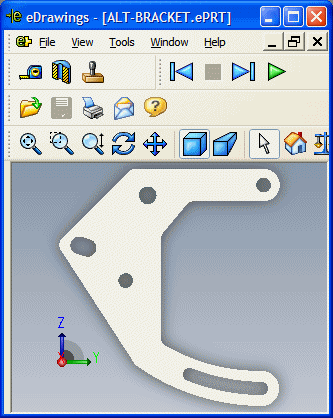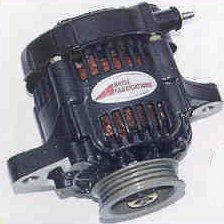Electrics - Page 3
LastPreviously....
DTA E48 and Zetec wiring
The section below was written when I ran the Zetec and DTA E48 ECU. The principles remain the same.I must stress that these schematics are for a competition car. For competition use, you don't need things like indicators, head lamps etc. The Fiesta is not running with a front bumper, so there wont be any front indicators on the car. Therefore the hazard lamps will only operate on the rear indicators.
I'm running all wires back to the fuse/control box which is located on the passenger floor in the car.
Zetec charging system
I've used a 50Amp Powermaster 'Denso' Race single wire alternator.During the concept stage of the engine transplant, I'd spent a long time trying to source an alternator small enough to fit in the gap at the front of engine. The Powermaster alternator has a 93mm diameter body, and weighs only 2.6Kg, and is probably the smallest alternator you can buy. Each Powermaster alternator is rebuilt specifically for racing application, featuring high quality bearings, which allow them to run at very high RPM without disintegrating. The alternator is rated at 50 Amperes, which should be more than enough for the fuel injection system. It has a single wire output, which connects to the main battery cable, and it has just two other connections. One is a switched battery positive supply, which enables the charging circuit within the alternator, and the other is a warning light connection. So if the alternator is not working correctly, I have two amber LED's on the dashboard to warn me.

A unique CNC machined aluminium bracket, manufactured locally from 10mm aluminium (BS EN 485-6082-T6), is used to locate the alternator on the front of the engine. On the Zetec engine, I used the Fiesta RS1800 front engine mounting, because it doubles up as an engine and alternator mounting bracket. Normally, the Zetec from the Mondeo has the alternator on the rear of the engine, but I cant fit one there, because of clearance problems with the front struts. The CNC machined aluminium bracket, which I can supply, requires no modifications to fit. The drive belt I used was bought from Halfords, called an HB887e, which is the perfect length to run round the alternator, crank and water pump pulleys.
The CNC alternator mounting brackets are available to buy, from our Merchandise page.
Picture of the Powermaster alternator

Alternator dimensions (click on picture for larger version)

Alternator electrical connections (click on picture for larger version)

Dashboard instrumentation - prior to 2009
I'm using a Stack ST-200 rev counter. The needle is driven by a tiny stepper motor, controlled by a microprocessor. It reacts instantaneously to changes in engine RPM, and it also features a tell tale button which moves the needle to the highest RPM recorded since the last reset. The LED's are ultra bright 10mm units from RSWWW.COM. They are amber to warn if the alternator has stopped charging, red to indicate low oil pressure, and blue to show when to change gear. I've installed a set of 7 segment digital gauges for battery voltage, oil pressure, and water temperature. These were supplied by www.summitracing.com in the United States. Excellent value, they come with transducers, but the only problem is that they're difficult to read in bright light. The LED's could do with being brighter.



